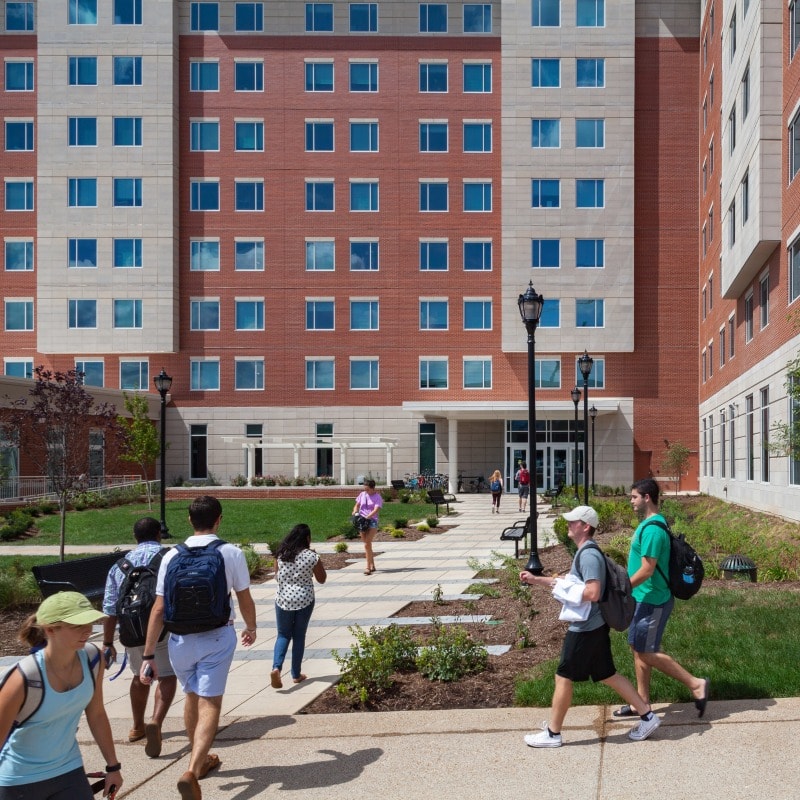Forces Shaping Private Higher Education Campuses in 2022

Wednesday, January 26, 2022
As campus architects, we are often reminded that our work not only involves architecture and design, but the myriad of market forces shaping how our clients respond to student needs and remain competitive. Understanding current conditions is integral to approaching campus architecture and design with an holistic, informed perspective.
With higher education’s outlook focused on the future with proven COVID response plans in place, it is important to explore the many forces affecting the landscape of higher education. Chris Chivetta, PE, LEED AP BD+C and Erik Kocher, AIA, LEED AP BD+C collaborated to explore the following topics affecting higher education campuses today and in the near future, as they relate to recruitment, retention, enrollment, and capital project planning.
Shifting Student Demographics
College and university demographics have been shifting in two primary ways in recent years. The first shift has been a long-standing concern for many college administrators – there is a substantial decrease in the number of college-eligible high school graduates from 2025 to 2030. But while there will be less students attending college during this time, a growing share of those in college will be people of global majority, or those who are black, indigenous, and people of color. These two trends represent broad transformations in the makeup of the college student population. To succeed in the changing higher education landscape, administrators must consider how to better appeal to college-aged students, elevate student success strategies, and ultimately prove their value.
Evolving Recruitment Strategies
Due to a decrease in the amount of college-eligible students and the shift in the needs, wants, and expectations of a growing share of people of the global majority who are attending college, strong recruitment strategies are more important than ever. Institutions with successful recruitment and retention strategies tend to be forward-thinking about the needs of current and future students. Such colleges and universities also champion diversity, equity, and inclusion. Diversity, equity, and inclusion efforts can effectively be expressed and implements through architectural design. Further, successful recruitment strategies not only consider how to get students on campus, but also what services and amenities are important to encouraging students to stay at an institution through graduation. Thoughtful architectural design can support positive learning outcomes by promoting learning and improving retention year over year. Of course, recruitment and enrollment trends can vary from institution to institution due to geography, campus context, history, and more. However, what remains vital is the need for colleges and universities to continually reassess strengths and areas for improvement in recruitment and retention efforts.
Preparation for New Construction
In the past couple years, there has been growing hesitancy to fuel large capital projects at many colleges and universities. For some institutions, the hesitancy to build or renovate may have its roots in tight funds and fundraising. Others may find themselves in a construction lull after years of continuous campus improvements. No doubt, Covid-19 has delayed capital improvements on many campuses. While large capital projects may not be a top priority for some administrators now, there are a number of proactive measures leaders can take to ensure long-term capital improvement success. Strategic plans, master plans, studies, and facility condition assessments are all forward-thinking efforts that can be completed relatively quickly with a lower financial investment. Such projects define goals and streamline the consensus-building and design process when it comes time for construction. By providing some direction for future improvements, colleges and universities can save time and money and strengthen the relationship between the institution’s vision and its built environment.
Increase in Donor-Driven Projects
Donor bases are also shifting within the higher education landscape. Whereas approximately 80% of funds were given by the top 20% of an alumni population in the past, now 90% of donations come from the top 5% of a given institution’s donor base. As such, today’s donors are more likely to be highly invested in their donation and expect substantial input in specific passion projects. Managing fundraising, donor expectations, and campus context all at once can be challenging for administrators. Colleges and universities must become adept at directing donor expectations toward a larger institutional vision.
E-learning is Here to Stay
Trends accelerated by necessity due to Covid-19, hybrid and blended learning will remain part of the higher education experience. Hybrid learning occurs when some individuals learn in person while others learn online. For example, a professor may teach half of their students in person while video conferencing another half of the class learning remotely. Blended learning involves both in-person and online instruction, yet online learning materials are meant to build upon content discussed in-person, not replace it. These types of flexible learning pedagogies will remain at least some part of the higher education experience. Even for traditional colleges and universities that champion in-person instruction, technology will continue to affect how traditional learning methods evolve. Individual colleges and universities are tasked with trying to understand how e-learning and technology affect present and future students, in terms of recruitment, retention, and educational outcomes.
The previous points are just a sampling of the many issues at the forefront of the higher education landscape. Our architects and designers are constantly learning from our industry partners and clients about the best strategies for higher education institutions. This knowledge and foresight, along with our decades of experience designing transformational facilities for colleges and universities across the country, helps us ensure the built environment of any campus we work on evolves to best reflect the strategic vision.